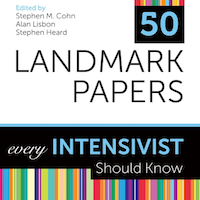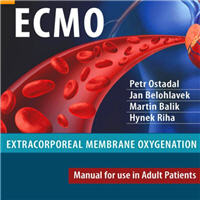Tag: study
Pre-ICU Statin Use, AKI and in Hospital Mortality in Sepsis Patients
Pre-ICU statin therapy is associated with a lower risk of acute kidney injury (AKI), and improved in-hospital survival among obese patients with sepsis, suggesting its potential role as a protective measure in this high-risk... read more
Factors Influencing the Mortality of Patients with Subarachnoid Hemorrhage in the ICU
Spontaneous subarachnoid hemorrhage (SAH) is a prevalent condition for those between the ages of 50 and 60 years, with a high mortality rate in severe cases. The findings of this study indicate that a history of loss... read more
Epidemiology of Myocardial Injury in Trauma Patients
Pathological Troponin concentration elevation occurs in 7% of all trauma patients and it identifies the seriously injured high-risk cohort with worse outcomes than expected based on injury severity. The timing of the... read more
Fungal Infections Surveillance and Prevention in the NICU
It was determined that colonization and development of invasive mycoses among newborns are most often caused by Candida sp., while the detection of filamentous fungi remains sporadic. The etiological role of Malassezia... read more
Prognostic Predictor Using Lactate-to-Albumin Ratio in Patients with Cirrhosis and Sepsis
Lactate-to-albumin ratio (LAR) is strongly associated with poor prognosis in patients with cirrhosis and sepsis. LAR is a promising prognostic marker that provides clinicians with a simple and effective tool for risk... read more
Mortality Predictor with sPAP in Elderly Critically Ill with Severe COVID-19 Pneumonia
Mortality in general ARDS patients remains high, with many experiencing long-lasting sequelae. Numerous studies have been conducted to identify predictors of mortality in COVID-19 patients, particularly regarding right ventricular... read more
Low Decent Work Perception Among PICU Nurses
The level of decent work perception among PICU nurses in general hospitals is relatively low and is influenced by factors such as age, educational level, professional title, average monthly income, and personal experience... read more
Diastolic Dysfunction Increases AKI Rick in COVID-19 Patients
Diastolic dysfunction increases the risk of acute kidney injury (AKI) in patients with severe COVID-19. Using point-of-care ultrasound (PoCUS) to assess left ventricular diastolic function in the ICU may be a useful parameter... read more
Barriers to Early Mobilization Perceived by PICU Staff
There is a need to implement educational and organizational interventions in the PICU to overcome the identified barriers. Training staff, clarifying roles and responsibilities, as well as promoting a culture that values... read more
Asthma Course Evaluation in PICU Due to Severe Asthma Exacerbation
Admission to the PICU due to severe asthma exacerbation not only increases the risk of recurrent asthma exacerbations but also serves as a risk factor for stepping up maintenance treatment according to GINA guidelines during... read more
Exploring the Effectiveness of HFNC in the Neurointensive Care Unit
The high flow nasal cannula (HFNC) is becoming increasingly prevalent in both adult and pediatric general intensive care. Despite limited reporting in neurocritical care, we have successfully utilized HFNC in our cohort... read more
Cytomegalovirus Infection in Immunocompromised ICU Patients: What Intensivists Need To Know
Cytomegalovirus (CMV) infection and disease in critically ill immunocompromised patients pose a unique challenge for intensivists. The broad spectrum of clinical presentations and the difficulty in distinguishing CMV-related... read more
Unlocking the Predictive Power of Nutritional Scores in Septic Patients
This study highlights the significant prognostic utility of nutritional status evaluation in septic patients admitted to internal medicine wards. Among the tools evaluated, the mNUTRIC score—likely because of its dual... read more
Dynamic Nomogram for AKI Prediction in ICU Patients with AHF
After strict screening, 1338 patients with acute heart failure (AHF) were included in the derivation set, and 3,129 in the validation set. Sepsis, use of human albumin, age, mechanical ventilation, aminoglycoside administration,... read more
Resource Utilization Associated with ECMO vs. Microaxial Flow Pump for Infarct-related Cardiogenic Shock
Microaxial flow pump was associated with lower resource utilization compared to venoarterial extracorporeal membrane oxygenation (VA-ECMO). Resource utilization should be incorporated in prospective RCTs and taken into account... read more
Risk Factors for Impairments in Quality of Life and Activities of Daily Living in Survivors of Critical Illness
This systematic review was able to identify that survivor of critical illnesses experienced changes in worsening quality of life, with impairment also in their functionality in terms of basic and instrumental activities of... read more
Central vs. Peripheral VA-ECMO Cannulation on Postoperative Graft Dysfunction in Lung Transplantation
Lung transplantation (LTx) is the definitive treatment for end-stage pulmonary diseases, with venoarterial extracorporeal membrane oxygenation (VA-ECMO) used as a common perioperative support. However, it remains unclear... read more
Unfractionated Heparin May Improve Near-term Survival in ICU Patients with Sepsis Pneumonia
This study found that early administration of heparin, particularly in sufficient doses (Heparin Sodium 5000 units/mL, 1 mL per dose, three times daily (TID)) for more than 7 d, was associated with reduced near-term mortality... read more
Management of Patients Supported with VA-ECMO
Veno-arterial extracorporeal membrane oxygenation (VA ECMO) application in adult patients has significantly increased in recent years. The Extracorporeal Life Support Organization (ELSO) registry includes more than 39,000... read more
Postoperative Liver Dysfunction After Lung Transplantation with Extracorporeal Life Support and 1-year Mortality
In this retrospective cohort study, we identified an elevated 1-year mortality rate among patients who developed postoperative liver dysfunction, as defined by the presence of HLD, DILI-like symptoms, and cholestasis subsequent... read more
Mental Health in the First Year After ICU-treated Sepsis
Existing data on the prevalence of mental health impairments (MHI) following sepsis and intensive care are based predominantly on self-reported symptoms assessed by using questionnaires, small sample sizes, and clinically... read more
Association Between the Lactate-to-Albumin Ratio (LAR) Index and AKI Risk in Critically Ill Patients with Sepsis
Lactate-to-albumin ratio (LAR) is an emergency predictive indicator of sepsis-related mortality. An elevated LAR is associated with poor outcomes in critically ill patients. However, its predictive value for acute kidney... read more









